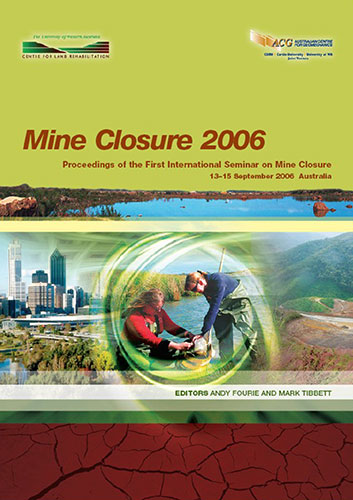Planning for In-Perpetuity Mine Closure Costs

|
Authors: Pierce, GL; Wen, ME Paper is not available for download Contact Us |
DOI https://doi.org/10.36487/ACG_repo/605_40
Cite As:
Pierce, GL & Wen, ME 2006, 'Planning for In-Perpetuity Mine Closure Costs', in AB Fourie & M Tibbett (eds), Mine Closure 2006: Proceedings of the First International Seminar on Mine Closure, Australian Centre for Geomechanics, Perth, pp. 487-492, https://doi.org/10.36487/ACG_repo/605_40
Abstract:
The Island Copper Mine was closed in December 1995. Reclamation of the site began in 1996 based on a closure plan approved by regulatory agencies. In 1994, when the Island Copper closure plan was submitted to government for approval the estimated closure costs were C$15 million, for environmental mitigation and monitoring with other money set aside for severance packages and decommissioning. The monitoring was planned for 10 years, with the latter five years at a significantly reduced level of effort. The company view at the time was that after five to ten years, the water quality at the site would meet regulatory standards and allow the company to return the land to the government. This did not happen. To date well in excess of this provision has been spent with additional expenditures planned to deal with the in-perpetuity obligation. After about five years, post-closure monitoring regulators requested the company to undertake studies to improve the understanding of the closed site. The company responded by undertaking comprehensive studies of the site, of which a main focus was on the pit lake semi-passive treatment system. This type of treatment was at the time untested in the world and Island Copper was the first site to treat its acid mine drainage by fertilizing and using a pit lake as a treatment system. The studies lead to improvement in the underlying science behind this unique treatment system, and ultimately lead to improvements to the system and to an updated closure plan. This reads like we only did it because we were pressured into doing something. I’m not sure if that’s true, but it does sound harsh. Hence my suggestion above so long as it doesn’t then become a misrepresentation. The closure plan was assessed for post-closure residual risks, which are those risks that remain after closure and reclamation activities have been executed. For each risk, the timing and probability of the risk eventuating were evaluated. The consequence of each risk, should it eventuate, was considered and the associated activities and costs were estimated. It became apparent through this closure planning process that that the care and maintenance, monitoring and management of the site would be required in-perpetuity because of the risks associated with the evolving nature of the mine drainage and the long-term requirement to treat this drainage. A discounted cash flow model captured the estimated costs for closure, with any cashflows after 50 years assumed to be incurred in- perpetuity. This in-perpetuity cost estimate is fully risked and can help estimate long-term liability at the site. For companies with a number of closed mines, this risk can be further managed through a portfolio approach.
References:
Poling, G.A. (1998) Island Copper Reclamation. Mining Environmental Management. November.
Government of Canada (1991) The State of Canada’s Environment. Environment Canada. ISBN 0-660-14237-6.
Robertson, A.M. and Shaw, S.G. (1999) The Concept of Custodial Transfer of Mined Land. In Proceedings of Mine,
Water and Environment, Seville Spain, September 13-17, Vol. 1, pp. 765-771.
Planning for In-Perpetuity Mine Closure Costs G.L. Pierce, M.E. Wen
492 Mine Closure 2006, Perth, Australia
© Copyright 2025, Australian Centre for Geomechanics (ACG), The University of Western Australia. All rights reserved.
View copyright/legal information
Please direct any queries or error reports to repository-acg@uwa.edu.au
View copyright/legal information
Please direct any queries or error reports to repository-acg@uwa.edu.au